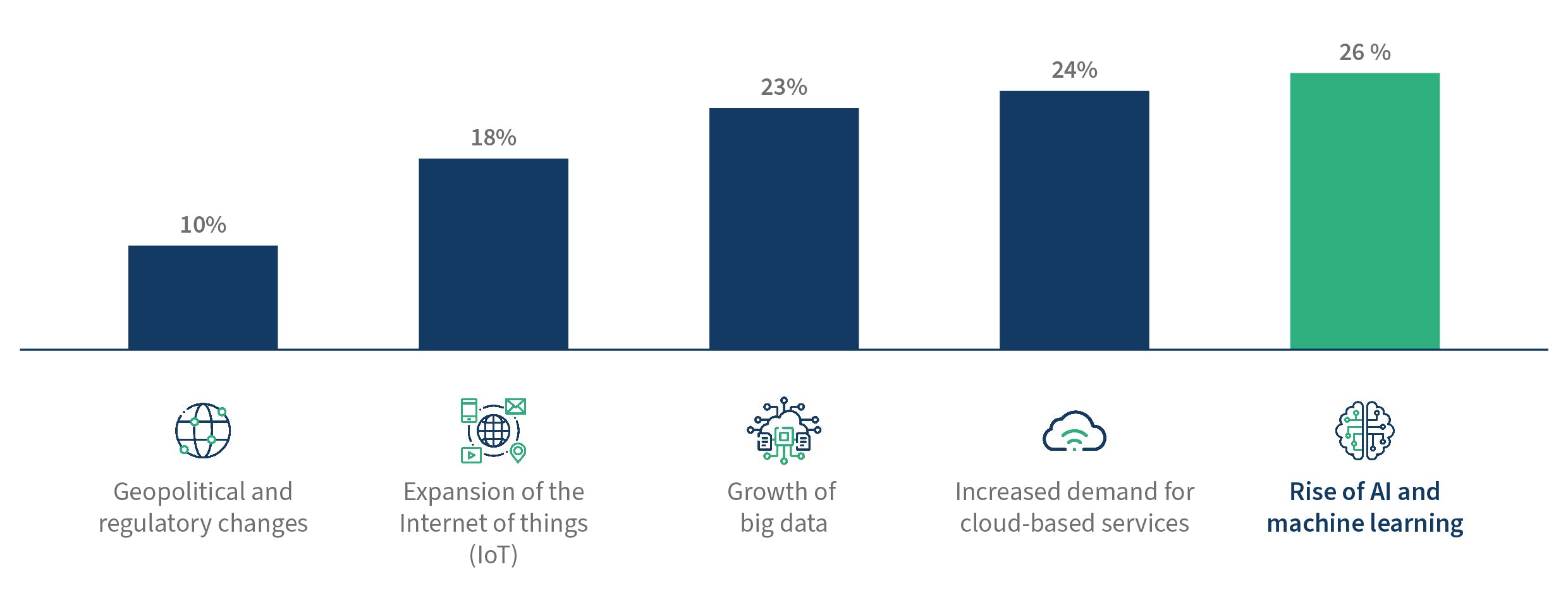2024 Technology Predictions
2024 Technology Predictions
In 2024, the tech landscape is poised for significant changes driven by a convergence of transformative trends and regulatory developments.

1. Regulation for AI becomes a reality, with implications for different regions
Artificial intelligence (AI) is one of the most transformative technologies of our time, and Generative AI (GenAI) has exponentially increased its relevance. Different regions around the world are developing their own regulatory frameworks for AI, reflecting their values, priorities and interests. We will briefly outline some of the main approaches that are emerging and how their differences will impact businesses and citizens.
The European Union (EU) has recently proposed a comprehensive AI Act that aims to establish a harmonized set of rules and standards for AI across the bloc. The AI Act would classify AI systems into four categories based on their risk level, and impose various obligations and restrictions on their developers and users. For example, high-risk AI systems, such as those used for biometric identification, would require a conformity assessment before being placed on the market and would have to comply with strict transparency and human oversight requirements. The EU’s approach is based on the principle of human-centric AI, which seeks to protect the fundamental rights and values of the people affected by AI. The EU aims to set a global standard for AI regulation, including the creation of a new European AI Office to supervise and enforce the new rules on general-purpose AI. This AI Office will be the first body globally enforcing binding rules on AI.
The United States, on the other hand, is taking a more market-oriented approach to AI regulation, with the AI Executive Order favoring a light-touch and sector-specific framework that encourages innovation and competition. The United States has not proposed any comprehensive legislation on AI, but rather relies on existing laws and regulations that apply to specific domains, such as health care, finance or transport. The United States also emphasizes the role of voluntary standards and best practices developed by industry and civil society groups to guide the ethical and responsible use of AI. Additionally, the AI Executive Order requires a strengthening of governance, compliance and accountability: the creation of the Chief Officer position, training, policies to track the use of AI, measures to protect data gathering from employees, etc. The U.S. approach is based on the principle of innovation-friendly AI, which seeks to foster the economic and social benefits of AI.
China follows a state-led approach, placing a lot of emphasis on the development of AI as a strategic tool for its global commercial and technological plans to make China a global leader in AI by 2030. China is also developing a legal and ethical framework for AI, which includes a national standard for personal information protection, a draft civil code that recognizes the legal status of AI, and a set of ethical principles for AI governance. China’s approach is based on the principle of strategic AI, which seeks to advance the national interests and security of China.

The Kingdom of Saudi Arabia (KSA) has taken a significant step with the introduction of an AI ethics principles framework aimed at reducing AI risks and enhancing privacy and data protection, paralleling the EU’s AI Act. This move reflects a similar risk-based approach that, while ensuring safety and ethical compliance, may potentially limit innovation compared to more liberal, market-driven models adopted by neighboring countries. This dichotomy could create a competitive advantage for nations adopting a less-stringent approach toward AI regulation. However, so far, no Middle East North Africa country, including those in the Gulf Cooperation Council, has fully established a national AI ethics framework. Although Qatar and the city of Dubai have initiated efforts, with Qatar incorporating AI ethics in its strategy and Dubai developing an AI ethics toolkit, there’s a clear opportunity for more robust policy development.
The EU AI Act, which will enter into force in two years, marks a more restrictive, risk-driven approach than the expected regulation in the United States, including the U.S. Executive Order. This will result in additional complications for the EU to reverse the flow of private capital and talent to the United States. China will remain competitive on the B2B and B2G fronts, thanks to public investments in key sectors, even if consumers will experience stronger supervision in the algorithms at their disposal. In the GCC, solving a significant AI skills gap is becoming a priority. Initiatives like Coders HQ are tackling this issue, but there remains a need for more comprehensive strategies to boost AI readiness and policy implementation. KSA has again taken the lead, launching the Future SDAIA Graduate Development Programme to attract, train and retain new talent for the authority.

2. Governments will develop AI strategies in 2024: Data, precision, and ethics
Governments are strategically aligning to leverage vertical AI strategies, aiming to boost innovation and efficiency across diverse industries. This shift is fueled by the recognition that tapping into specific industry and sector data, including personal information, is crucial for unlocking the full potential of AI applications.
A useful tool in this journey is synthetic data, which offers an 80/20 approach to jump-start innovation while ensuring confidentiality and eliminating biases in AI outcomes. Well-prepared synthetic data not only facilitates the training of AI models but also serves as a practical solution to the challenges associated with accessing private data.
While the 80/20 approach is a promising start, the real game-changer lies in achieving an accuracy level exceeding 99.8%. Precision is crucial for real-time automation, particularly in regulated industries such as transportation, finance and healthcare. Given that current large language models (LLMs) have an accuracy rate of only 70%-80%, collaboration between industries and sectors is imperative to achieve the desired 98% accuracy. Government intervention is necessary to align regulations with AI innovation, ensuring data protection and minimizing risks associated with inaccurate AI outcomes.
Governments must create policies and laws to protect innovators from the anticipated failure rate of AI applications, especially in areas such as autonomous vehicles. Governments must strike a balance between industry-specific risk tolerance and the costs of failure by actively supporting AI initiatives, adjusting laws and investing in infrastructure evolution. Establishing AI regulators and embedding AI in sector regulations are crucial steps for ensuring responsible and ethical AI deployment. In addition, it is critical for governments to regulate AI within the framework of its integration with other emerging technologies such as blockchain, robotics, automation and image recognition. This regulation is vital because it will have a substantial impact on a country’s potential for creating value and exposure to risks.

3. AI leads the way in Cloud expansion towards Edge
Artificial intelligence emerges as a key catalyst for transforming the deployment of cloud infrastructure, specifically pushing it towards the edge. The current scenario witnesses hyperscalers strategically localizing resources in major cities, a trend driven by the growing demands for cloud services and the need to secure confidential and regulated information within national borders. However, the integration of AI into cloud systems is set to redefine this localization paradigm, amplifying the requirements for storage and computing resources at the city level.
Telcos, acknowledging the potential of AI to optimize and automate networks, are leading this transformation. The optimization of Radio Access Network (RAN) and Open RAN, including the management and prioritization of network/service slices, emerges as a crucial use case for AI in network management. To establish efficient edge compute capabilities at the network level, computing capabilities must be localized at the edge. This drives the rapid deployment of cloud RAN architectures, making the convergence of cloud RAN and edge cloud integration crucial.
in your opinion, what are the key drivers for the growth of data center marketS in 2023-2024?

Source: FTI Delta
The implications of this trend extend beyond network optimization. Edge computing capabilities position the network as a dynamic platform for innovation, facilitating advancements in augmented and virtual reality, automation, and drone technologies. Additionally, the increasing sophistication and relevance of edge use cases elevate the importance of cybersecurity. As networks virtualize and autonomy rises, so does the cyber risk. To tackle this challenge, it is imperative to deploy AI-based cyber capabilities, reinforced by robust cloud resources at the edge. This symbiotic relationship between AI and cloud expansion not only ensures network protection but also paves the way for a new era of transformative and secure edge computing.

4. AI plays a dual role in shaping the Cybersecurity landscape
Artificial Intelligence plays a dual role in shaping the cybersecurity landscape, serving both as a robust defense mechanism and a potential threat.
On the defensive front, AI, particularly in the form of machine learning in security solutions, has matured into a commonly seen tool for analyzing extensive datasets, identifying anomalies, and responding to cyber threats in real time. These automated solutions expedite threat detection and incident response, offering swift actions and enhancing accuracy for human analysts. However, a cautious balance is necessary, as an overreliance on AI-driven security controls, without addressing fundamental measures or acknowledging the potential for AI failures, can undermine these advantages.
AI poses a threat to businesses on two fronts: the exploitation by malicious actors and the potential risks stemming from improper implementation by organizations seeking to harness its capabilities. AI, wielded by malicious actors, can be used to execute impersonation attacks utilizing voice cloning, deepfakes and written-style impersonation. More realistic phishing, smishing and vishing increase the effectiveness of existing threats such as CEO impersonation fraud and social engineering attacks to gain access to networks. Regularly reassessing controls against the evolving threat landscape is imperative to differentiate those organizations that thrive with the advancements of AI from those that fall victim.
Although AI-enabled malware and botnets have not yet materialized, the potential is evident as technology advances. AI’s democratization lowers barriers for less-skilled threat actors to develop malware, phishing messages, identify vulnerabilities and execute attacks, empowering them to exceed their capabilities.
Further, AI’s impact extends beyond malicious use by posing risks through unauthorized employee use, leading to data leakage and reputational harm. Even legitimate use requires precautions, as AI integration could expand an organization’s attack surface. Poisoning attacks targeting AI models may subvert associated systems if input sanitization is lacking. Addressing bias and privacy concerns is crucial to compliance with current and future regulations.
As AI accessibility increases, organizations must adopt a dual perspective: leveraging AI for defense while remaining vigilant about potential AI-driven threats. This balanced approach is paramount for navigating the ever-evolving cybersecurity landscape.

5. Tech organizations reimagine their R&D portfolio investments with GenAI
The tech landscape is undergoing a fundamental shift driven by the explosive potential of GenAI. By 2026, over 80% of enterprises are projected to embrace this technology, marking a significant leap from the current 5% adoption rate (Gartner) and presenting tech organizations with a critical opportunity to reimagine their R&D portfolio investments.
Accessibility is another catalyst, with user-friendly APIs and models empowering non-technical teams to join the AI revolution. Leaders must prepare for a future where hyper-personalization becomes the norm, data centers achieve unprecedented density and efficiency, and internal innovation explodes as citizen developers employ low-code/no-code platforms.
2024-2028 growth rates by service category

Generic technology solutions are relics of the past. Today’s business leaders understand the power of hyper-focused R&D. By aligning research with specific operational needs and challenges, solution providers are developing custom-built solutions with tangible impact. This strategic shift is evident in the surge of investments in growth-oriented sectors like cloud infrastructure (Omdia predicts cloud spending growth remains resilient and will continue to drive the growth of ICT spending through 2027, leading through IaaS), cybersecurity and AI. The payoff is undeniable: differentiated offerings tailored to a niche market achieve higher ROI through targeted development and accelerate innovation cycles that keep tech companies ahead of the curve.

6. Large enterprises adopt FinOps to transform Cloud governance
For many tech organizations, the cloud’s initial promise of scalability and innovation led to a spending surge that left businesses with growing technical debt and eroding profitability. Enter FinOps, the data-driven framework poised to revolutionize cloud governance, not merely as a cost-control mechanism but as a strategic catalyst for innovation and sustainable growth. A recent study by Gartner predicts that by 2026, 70% of large enterprises will adopt FinOps practices, highlighting its growing importance in the cloud landscape.
Imagine a future where AI-powered insights anticipate and prevent budget overruns, allowing tech organizations to navigate multi-cloud deployments with finesse. FinOps creates a unified umbrella under which data-driven decision-making and strategic financial management converge, driving organizational success. To further amplify this collaborative approach, FinOps seamlessly integrates with DevOps practices, creating a synergy between financial and operational functions.
FinOps transcends departmental silos, evolving into a strategic business partner. It aligns cloud usage with core objectives, driving impactful initiatives. Think of FinOps teams collaborating with R&D departments to optimize cloud resources for research projects, unlocking cost-effective yet powerful computing capabilities. Implementing FinOps practices can lead to cost savings of up to 30% (The FinOps Foundation).
FinOps is not simply a cost-saving measure; it’s a strategic imperative for businesses seeking to thrive in the ever-evolving cloud landscape. As cloud technology evolves, FinOps stands at the forefront, actively managing your cloud costs and optimizing financial operations to ensure long-term success. In 2024, it’s not about surviving the cloud, it’s about harnessing its power for competitive advantage and sustainable growth.

7. Real time, hyper-personalization to drive revenue growth in the tech space
In the fiercely competitive tech landscape, maximizing customer lifetime value (CLTV) is of utmost importance. Traditional cross-sell and up-sell strategies are evolving, fueled by data, automation and a relentless focus on delivering value. Gartner predicts that 60% of tech companies will offer such streamlined cross-sell experiences by 2025. But it’s not just about big leaps; micro-engagements powered by AI and data analytics, such as in-app suggestions and personalized email campaigns, can unlock 20% higher cross-sell conversion rates by catering to specific needs in the right moments. The key lies in providing seamless, personalized experiences that prioritize customer value.
Imagine a future where frictionless one-click upgrades, automated configurations and seamless data migration empower GTM teams to unlock the true potential of hyper-personalization in real time and where strategic investments in robust data infrastructure and advanced AI and automation capabilities can foster deeper connections and transform efficiency into a catalyst for building trust and loyalty.
But the transformation goes beyond technological capabilities; tech companies must move beyond features and showcase the tangible ROI their solutions deliver. This value-based approach positions tech companies as strategic partners, not just vendors. It builds trust, fosters long-term relationships and ensures customers invest in solutions that truly add value to their businesses.
Disney’s total experience focuses benefits

Furthermore, in today’s fragmented omnichannel landscape, a seamless brand narrative is paramount. Creating a unified ecosystem that provides a seamless experience across email, mobile apps, in-store interactions and social media is no longer a luxury, but a necessity to build deeper customer connections and drive engagement.
Customer engagement transformation is not merely a pursuit of higher CLTV; it’s a strategic imperative for long-term success in a customer-focused future that requires embracing data-driven insights and hyper-personalization.

8. A resurgence in data infrastructure investments helps capitalize on AI and ML opportunities
The anticipated resurgence in data infrastructure investments is underway in 2024, fueled by large enterprises seeking to capitalize on the nascent AI and machine-learning opportunities. Following a period of restrained funding in 2022 and 2023, major players are strategically revamping their data collection, management and storage capabilities to unlock the full potential of these transformative technologies.
This renewed focus is already evident in the growing investment landscape, with data software and systems vendors experiencing a significant upswing. Investment in this sector has climbed from $482 million in 1Q23 to $945 million in 3Q23 and is projected to remain elevated throughout 2024 (Gartner, Top 10 Strategic Trends 2024). This trend signifies a renewed commitment to data monetization and utilization, placing data infrastructure vendors at the forefront of the next technological wave. This shift towards robust data infrastructure capabilities, coupled with a clear focus on AI and machine learning (ML) integration, signifies a strategic move by enterprises to thrive in the burgeoning data-driven landscape.
Furthermore, 2024’s investment focus will move beyond siloed big data platforms and extract, transform and load (ETL) tools. We expect a strategic shift towards robust data governance frameworks, comprehensive security solutions and seamless integration across diverse platforms. This holistic approach, which is particularly critical for large enterprises, aligns with the rise of complex AI applications. Transparency, ethical development practices and bias mitigation tools will become paramount to ensure responsible AI development and build both consumer and regulatory trust. Solution providers prioritizing these principles will secure a competitive edge in this rapidly evolving landscape, shaping the future of this innovative technology.

9. Wider accessibility to AI will accelerate technology’s advancement and adoption
Recognizing the need for wider accessibility, 2024 will see the rise of “freemium” models offering basic AI functionalities for free while charging for advanced features or premium access. This democratization fuels a vibrant ecosystem of innovation and experimentation, where open-source communities flourish and developers collaborate on shared tools, accelerating the technology’s advancement and adoption.
Imagine a collaborative platform where businesses can share their AI models, test them on diverse datasets and contribute to the collective advancement of the technology. This open-source spirit fosters trust, transparency and faster development, ensuring GenAI benefits everyone, not just select corporations.
A larger "freemium" user base unlocks scalable revenue opportunities. Richer data sets enable data monetization through insights into user preferences and trends, informing product development and market strategies. Additionally, targeted advertising within the platform can yield further revenue streams. As users experience the limitations of free models, demand for premium, paid offerings will rise. This unveils the vast potential of GenAI, incentivizing users to upgrade for advanced functionalities and features. Striking the right balance between a compelling free tier and valuable premium additions will be key to monetization success.


